-Celine Katzman
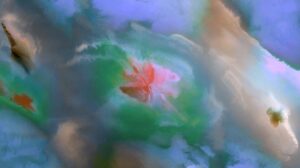
Sara Ludy’s practice spans websites, animation, video, sculpture, and audio-visual performance. Her work investigates the liminal space between virtual and physical, featuring architectures and objects that evoke conceivable earthly scenes, yet feel supernatural due to their digital texture. I spoke with Sara about her archival approach, animation process, and the symbiotic relationship between her lucid dreams and VR practice.
Where did you grow up and where do you live now?
I was born in Orange, CA and raised in Bluemont, VA., a small rural town between Mount Weather and the Appalachian Trail. I currently live in Chicago.
Where did you go to school?
I studied new media, sound, and painting at SAIC.
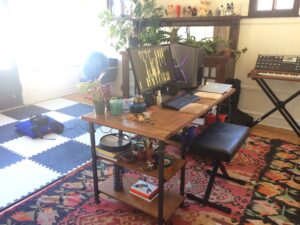
What does your studio look like?
I converted my dining room into a studio. It’s cozy and full of plants.
When did you start working creatively with technology?
In high school, I made collaged tape recordings and drew alien costumes in MacPaint. I also learned Photoshop.
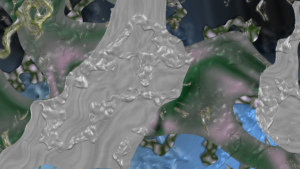
Your series Clouds pushes the constraints of software defaults to evoke natural phenomenon without the use of outside source material. Can you describe the process of making the animations in this series? Do you work on several simultaneously or one at a time? Are you working with custom or pre-existing software? How is the series evolving?
Clouds are made using fractal and turbulence plugins, which simulate natural phenomena. I use these plugins to generate dozens of images; all with varying patterns, colors, and movement. When the images are layered, a painterly animation takes form. Clouds first emerged from an interest in wanting to make atmospheric projections that resonate a sense of place through abstraction. Since 2011, the series has expanded to include other forms; water, plants, animals, fabric and glass. I’m currently working on two, and have ten or so unfinished. Pond Wave is the most recent.
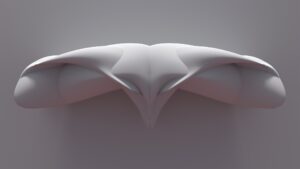
Your series Animistics is a collection of sculptural forms inspired by lucid dreams and sacred spaces. They’re legible as believable objects, yet seem completely otherworldly. Did you often dream lucidly before or was it something you learned and practiced for this project? Over time, did the architecture and spaces in your dreams begin reflecting the ones you consciously construct in your work, or have they always influenced each other?
The first lucid dream I remember was in 2002. I woke up in a yellow bedroom with no indication I was dreaming until I looked at myself in the mirror. The second lucid dream I had was in 2007 when my best friend passed away. We embraced in a kitchen. Both of these rooms are in Dream House. Since then, I’ve had many lucid experiences. Flying and shape-shifting mansions are recurring themes.
My dreams and practice cocreate often. Lately, I’ve been having dreams of my VR aviary and have adjusted the environment according to the dream experiences. Since the physical world is peripherally absent in both dreaming and VR, the journey from one to another has the potential to feel seamless, making world building a lot of fun. Dreams and virtual reality are ideal collaborators.
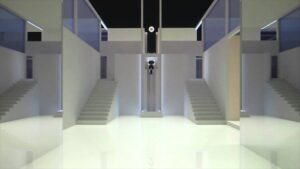
http://low-prim.com/ features curated selections from a living archive of found images contained in a folder on your desktop published on the occasion of your exhibition Subsurface Hell. Have you continued to update the folder since the exhibition opened in 2016? Has the process of arranging and publishing this image diary changed the way you manage your personal archive?
The archive contains a plethora of images I’ve been collecting since 2001. It’s intentionally unorganized, allowing me to seek new relationships between the images when I dive in. I’m still adding to the archive but haven’t made many new posts since the show, maybe three. I’ve been focusing on other bodies of work, generating content rather than amassing it.
What projects are you currently working on?
I’m building a VR aviary for Dream House, making glass sculptures, more cloud animations, a birding book, some paintings, among one thousand more ideas I wish to manifest.
In a field where hardware and software can quickly become obsolete, how do you approach documentary and archival processes for your artwork?
I back up work in the cloud/on drives/at my gallery while accepting obsolescence will occur. I don’t have anxiety about this, as digital media is inherently temporary and fleeting. Erosion and data loss are part of its aesthetic.
Who are some contemporary or historical new media artists that you admire? What are some of your favorite works?
Visionaries whom I admire are Georgia O’Keeffe, Alice Coltrane, Jane Goodall, Francine Patterson, Jorge Luis Borges, James Turrell, Gordon Matta-Clark, Trevor Paglen, Alex Da Corte, Kay Sage and Buckminster Fuller; to name a few. My favorite works are columnar basalt and bird songs.
Top image: Cloud Pond 1, 2015, HD Animation, 3:00; Courtesy bitforms gallery. [/vc_column_text]
